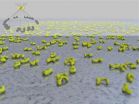(Press-News.org) Washington, D.C. – Quitting smoking is a common New Year's resolution for Americans each year, but research has repeatedly shown it is not an easy task. Some groups, such as racial/ethnic minorities, have an even harder time quitting. New research suggests hard-hitting graphic tobacco warnings may help smokers of diverse backgrounds who are struggling to quit. A new study by researchers at Legacy® and Harvard School of Public Health provides further evidence that bold pictorial cigarette warning labels that visually depict the health consequences of smoking — such as those required under the 2009 Family Smoking and Prevention Tobacco Control Act — play a life-saving role in highlighting the dangers of smoking and encouraging smokers to quit.
The study is one of the first to examine the effectiveness of pictorial warning labels versus text-only labels across diverse racial/ethnic and socioeconomic groups. Although a growing body of research has shown that disadvantaged groups may differ in their ability to access, process and act on health information, little is known about communication inequalities when it comes to cigarette warning labels.
The study authors note that text-only cigarette warnings have been repeatedly characterized as unlikely to be noticed or have an impact, and cite prior research indicating pictorial warning labels are more effective.
"Interventions that have a positive impact on reducing smoking among the general population have often proven ineffective in reaching disadvantaged groups, worsening tobacco-related health disparities," said Jennifer Cantrell, DrPH, MPA, and Assistant Director for Research and Evaluation at Legacy®, a national public health foundation devoted to reducing tobacco use in the U.S. "It's critical to examine the impact of tobacco policies such as warning labels across demographic groups."
Senior author Vish Viswanath, associate professor of society, human development, and health at Harvard School of Public Health, said, "There is a nagging question whether benefits from social policies accrue equally across ethnic and racial minority and social class groups. The evidence from this paper shows that this new policy of mandated Graphic Health Warnings would benefit all groups. Given the disproportionate burden of tobacco-related disease faced by the poor and minorities, mandating strong pictorial warnings is an effective and efficient way to communicate the risk of tobacco use."
The new study, published January 14, 2013, in the journal PLOS ONE, examined reactions to cigarette warning labels from more than 3,300 smokers. Results show that hard-hitting, pictorial graphic warnings are more effective than text-only versions, with smokers indicating the labels are more impactful, credible, and have a greater effect on their intentions to quit. Moreover, the study found that the stronger impact of pictorial warnings was similar across vulnerable subpopulations, with consistent reactions across race/ethnicity, education, and income.
"The implementation of graphic warning labels appears to be one of the few tobacco control policies that have the potential to reduce communication inequalities across groups," Cantrell said.
"Tobacco use is a social justice issue," added Donna Vallone, PhD, Senior Vice President for Research and Evaluation at Legacy®. "Given that low income and minority communities have higher smoking rates and suffer disproportionately from tobacco's health consequences, studies like this show us that graphic warning labels can help us reach these subgroups in a more effective way, ultimately saving more lives."
###
Background:
More than 400,000 Americans die each year as a result of tobacco-related diseases, which include heart disease, cancers, emphysema, and stroke.
The U.S. Family Smoking Prevention and Tobacco Control Act of 2009 required new graphic health warnings that depict the negative health consequences of smoking to be placed on cigarette packages and in cigarette advertisements by September 2012. However, the new labels have been blocked by tobacco companies who have challenged the constitutionality of the Act and its provisions.
The study adds to the research on the effectiveness of graphic warning labels on tobacco products, providing evidence that the FDA-approved pictorial warning labels would achieve their desired effect without exacerbating inequalities, thus enhancing the efficiency and cost-effectiveness of warning label policy.
The study will be available on the PLOS ONE website after the embargo lifts: http://dx.plos.org/10.1371/journal. pone.0052206
Support for the study was provided by Legacy.
Legacy helps people live longer, healthier lives by building a world where young people reject tobacco and anyone can quit. Legacy's proven-effective and nationally recognized public education programs include truth®, the national youth smoking prevention campaign that has been cited as contributing to significant declines in youth smoking; EX®, an innovative public health program designed to speak to smokers in their own language and change the way they approach quitting; and research initiatives exploring the causes, consequences and approaches to reducing tobacco use. Located in Washington, D.C., the foundation was created as a result of the November 1998 Master Settlement Agreement (MSA) reached between attorneys general from 46 states, five U.S. territories and the tobacco industry. To learn more about Legacy's life-saving programs, visit www.LegacyForHealth.org.
Follow us on Twitter @legacyforhealth and Facebook www.Facebook.com/Legacy.
Harvard School of Public Health is dedicated to advancing the public's health through learning, discovery, and communication. More than 400 faculty members are engaged in teaching and training the 1,000-plus student body in a broad spectrum of disciplines crucial to the health and well being of individuals and populations around the world. Programs and projects range from the molecular biology of AIDS vaccines to the epidemiology of cancer; from risk analysis to violence prevention; from maternal and children's health to quality of care measurement; from health care management to international health and human rights. For more information on the school visit: http://www.hsph.harvard.edu
HSPH on Twitter: http://twitter.com/HarvardHSPH
HSPH on Facebook: http://www.facebook.com/harvardpublichealth
HSPH on You Tube: http://www.youtube.com/user/HarvardPublicHealth
HSPH home page: http://www.hsph.harvard.edu
Graphic warnings on cigarettes effective across demographic groups
Disadvantaged groups stand to benefit from hard-hitting tobacco warnings
2013-01-15
ELSE PRESS RELEASES FROM THIS DATE:
AGU journal highlights -- Jan. 14, 2013
2013-01-15
The following highlights summarize research papers that have been recently published in Geophysical Research Letters (GRL), Journal of Geophysical Research – Oceans (JGR-C), Journal of Geophysical Research-Biogeosciences (JGR-G) and Water Resources Research.
In this release:
1. Seabird activity influences Arctic methane and nitrous oxide emissions
2. U.S. cities less susceptible to water scarcity than previously thought
3. First direct evidence that breaking waves cause horizontal eddies
4. Variability of transparent organic particles in Arctic floodplain lakes
5. ...
Study finds knee replacement surgery may lead to weight gain
2013-01-15
RICHMOND, Va. (Jan. 14, 2013) – Patients who undergo knee replacement surgery may be at risk of gaining more weight than their peers who have not had the surgery, according to a five-year study led by a Virginia Commonwealth University professor.
Daniel Riddle, Ph.D., professor in the VCU Department of Physical Therapy in the School of Allied Health Professions, and his research team reviewed the medical records of nearly 1,000 knee-replacement surgery patients from the Mayo Clinic Health System and found that 30 percent of them gained 5 percent or more of their body ...
If we go over the fiscal cliff, will people spend or save? Childhood environments may hold the key
2013-01-15
In the face of hard times, which strategy gives us the best shot at survival: saving for the future or spending resources on immediate gains? The answer may depend on the economic conditions we faced in childhood, according to new research published in Psychological Science, a journal of the Association for Psychological Science.
Drawing on life history theory, Vladas Griskevicius of the University of Minnesota's Carlson School of Management and colleagues hypothesized that the strategy a person takes when times are tight may be determined, at least in part, by features ...
4,000-year-old shaman's stones discovered near Boquete, Panama
2013-01-15
Archaeologists working at the Smithsonian Tropical Research Institute in Panama have discovered a cluster of 12 unusual stones in the back of a small, prehistoric rock-shelter near the town of Boquete. The cache represents the earliest material evidence of shamanistic practice in lower Central America.
Ruth Dickau, Leverhulme Post-doctoral Fellow at the University of Exeter in England, unearthed the cache of stones in the Casita de Piedra rock-shelter in 2007. A piece of charcoal found directly underneath the cache was radiocarbon dated to 4,800 years ago. A second fragment ...
NIH scientists identify protective role for antibodies in Ebola vaccine study
2013-01-15
WHAT: Researchers at the National Institutes of Health (NIH) and Oregon Health & Science University (OHSU) have found that an experimental vaccine elicits antibodies that can protect nonhuman primates from Ebola virus infection. Ebola virus causes severe hemorrhagic fever in humans and nonhuman primates, meaning that infection may lead to shock, bleeding and multi-organ failure. According to the World Health Organization, Ebola hemorrhagic fever has a fatality rate of up to 90 percent. There is no licensed treatment or vaccine for Ebola virus infection.
Several research ...
Rice researchers see surprising twist to protein misfolding
2013-01-15
An effort to develop software that unravels the complexities of how proteins fold is paying dividends in new findings on how they misfold, according to researchers at Rice University.
The study published this week in the Proceedings of the National Academy of Sciences by chemist Peter Wolynes and his team at Rice's BioScience Research Collaborative should be of particular interest to those who probe the roots of degenerative diseases associated with the aggregation of amyloid fibers in the body. These include Alzheimer's and Parkinson's diseases and Type 2 diabetes.
The ...
Diet may not impact certain health outcomes in older persons
2013-01-15
UNIVERSITY PARK, Pa. -- Eating diets high in sugar and fat may not affect the health outcomes of older adults ages 75 and up, suggesting that placing people of such advanced age on overly restrictive diets to treat their excess weight or other conditions may have little benefit, according to researchers at Penn State and Geisinger Healthcare System.
"Historically people thought of older persons as tiny and frail," said Gordon Jensen, head of the Department of Nutritional Sciences at Penn State, "but that paradigm has changed for many older persons. Currently, 30 percent ...
Will changes in climate wipe out mammals in Arctic and sub-Arctic areas?
2013-01-15
The climate changes depicted by climatologists up to the year 2080 will benefit most mammals that live in northern Europe's Arctic and sub-Arctic land areas today if they are able to reach their new climatic ranges. This is the conclusion drawn by ecologists at Umeå University in a recently published article in the journal Plos ONE.
The scientists Anouschka Hof, Roland Jansson, and Christer Nilsson of the Department of Ecology and Environmental Science at Umeå University investigated how future climate changes may come to impact mammals in northern Europe's Arctic and ...
Generic HIV treatment strategy could save nearly $1 billion annually but may be less effective
2013-01-15
NEW YORK (Jan. 14, 2013) -- Replacing the combination of brand-name, antiretroviral drugs currently recommended for control of HIV infection with soon-to-be-available generic medications could save the U.S. health care system almost $1 billion a year but may diminish the effectiveness of HIV treatment. A study led by Massachusetts General Hospital (MGH) and Weill Cornell Medical College investigators, appearing in the January 15 Annals of Internal Medicine, examines the potential impact of such a change.
"The switch from branded to generic antiretrovirals would place ...
Scientists discover structure of protein essential for quality control, nerve function
2013-01-15
LA JOLLA, CA – January 14, 2013 – Using an innovative approach, scientists at The Scripps Research Institute (TSRI) have determined the structure of Ltn1, a recently discovered "quality-control" protein that is found in the cells of all plants, fungi and animals.
Ltn1 appears to be essential for keeping cells' protein-making machinery working smoothly. It may also be relevant to human neurodegenerative diseases, for an Ltn1 mutation in mice leads to a motor-neuron disease resembling amyotrophic lateral sclerosis (ALS, also known as Lou Gehrig's disease).
"To better ...
LAST 30 PRESS RELEASES:
UT Health San Antonio awarded $3 million in CPRIT grants to bolster cancer research and prevention efforts in South Texas
Third symposium spotlights global challenge of new contaminants in China’s fight against pollution
From straw to soil harmony: International team reveals how biochar supercharges carbon-smart farming
Myeloma: How AI is redrawing the map of cancer care
Manhattan E. Charurat, Ph.D., MHS invested as the Homer and Martha Gudelsky Distinguished Professor in Medicine at the University of Maryland School of Medicine
Insilico Medicine’s Pharma.AI Q4 Winter Launch Recap: Revolutionizing drug discovery with cutting-edge AI innovations, accelerating the path to pharmaceutical superintelligence
Nanoplastics have diet-dependent impacts on digestive system health
Brain neuron death occurs throughout life and increases with age, a natural human protein drug may halt neuron death in Alzheimer’s disease
SPIE and CLP announce the recipients of the 2025 Advanced Photonics Young Innovator Award
Lessons from the Caldor Fire’s Christmas Valley ‘Miracle’
Ant societies rose by trading individual protection for collective power
Research reveals how ancient viral DNA shapes early embryonic development
A molecular gatekeeper that controls protein synthesis
New ‘cloaking device’ concept to shield sensitive tech from magnetic fields
Researchers show impact of mountain building and climate change on alpine biodiversity
Study models the transition from Neanderthals to modern humans in Europe
University of Phoenix College of Doctoral Studies releases white paper on AI-driven skilling to reduce burnout and restore worker autonomy
AIs fail at the game of visual “telephone”
The levers for a sustainable food system
Potential changes in US homelessness by ending federal support for housing first programs
Vulnerability of large language models to prompt injection when providing medical advice
Researchers develop new system for high-energy-density, long-life, multi-electron transfer bromine-based flow batteries
Ending federal support for housing first programs could increase U.S. homelessness by 5% in one year, new JAMA study finds
New research uncovers molecular ‘safety switch’ shielding cancers from immune attack
Bacteria resisting viral infection can still sink carbon to ocean floor
Younger biological age may increase depression risk in older women during COVID-19
Bharat Innovates 2026 National Basecamp Showcases India’s Most Promising Deep-Tech Ventures
Here’s what determines whether your income level rises or falls
SCIE indexation achievement: Celebrate with Space: Science & Technology
Children’s Hospital Colorado performs region’s first pediatric heart and liver dual organ transplant
[Press-News.org] Graphic warnings on cigarettes effective across demographic groupsDisadvantaged groups stand to benefit from hard-hitting tobacco warnings


